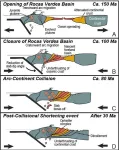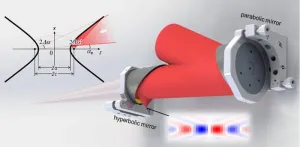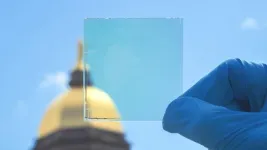(Press-News.org) Scientists use tiny minerals called zircons as geologic timekeepers. Often no bigger than a grain of sand, these crystals record chemical signatures of the geological environment where they formed. In a new study led by scientists at The University of Texas at Austin, researchers used them to describe what could be an overlooked step in a fundamental tectonic process that raises seafloors into mountains.
In a study published in the journal Geology, the researchers describe zircons from the Andes mountains of Patagonia. Although the zircons formed when tectonic plates were colliding, they have a chemical signature associated with when the plates were moving apart.
The researchers think that the unexpected signature could be explained by the mechanics of underlying tectonic plates that hasn’t yet been described in other models. This missing step involves a sort of geologic juicing in a magma chamber where zircons form before they reach the surface, with oceanic crust entering the chamber ahead of continental crust.
“If you put some oceanic basin below this magma, you have a change in the composition of this magma as it’s incorporated,” said the study’s lead author Fernando Rey, a doctoral student at the UT Jackson School of Geosciences. “This is something that was not documented before this study.”
This theory of oceanic magma mixing is important because it could represent a transitional step in the formation of back arc basins – an important geological structure that shapes landscapes, geologic records and helps regulate the planet’s climate.
These basins form between oceanic and continental tectonic plates, opening up as the plates move apart and closing as they come back together. While the opening of the basin creates oceanic crust, its closing squeezes the crust into mountains – bringing a geologic record of Earth history to the surface where humans can more easily access it, said coauthor Matt Malkowski, an assistant professor at the Jackson School’s Department of Earth and Planetary Sciences. What’s more, the weathering of the ocean crust is a major driver of natural carbon dioxide storage.
“This is the Earth’s way of sequestering carbon. Very effective on its own, but it may take hundreds of thousands if not millions of years,” said Malkowski.
Malkowski collected the zircons examined in the study from rock and sediment samples at a field site in Patagonia. The samples captured the entire record of the back arc basin, called the Rocas Verdes Basin, from opening to closing.
When Rey started analyzing the chemical signatures of the zircons, nothing looked out of place at first. The zircons associated with an opening basin had the expected signature. However, when he started examining zircons associated with the closing of the basin, the signature didn’t undergo the expected chemical shift – known to scientists as a “pull down” because of the way data plotting the isotope ratios goes from steadily rising to falling down.
When that pull down signature didn’t show up until 200 million years later, appearing in zircons that formed 30 million years ago when the basin was already well into its closure phase, Rey and his collaborators hypothesized a scenario that could help explain the data.
In their paper, they propose a model where the same tectonic forces that squeeze the oceanic crust into mountains could be underthrusting parts of that crust and pushing it toward the magmatic chamber where the zircons are formed – influencing the chemical signatures recorded in the crystals during the early to middle stages of closure. As the continents continue to squeeze together, the oceanic crust is eventually replaced by continental crust, the source of the pulldown signal.
The researchers think this transitional phase where zircons are juiced by oceanic crust could be part of back arc basins around the world. But there’s a good reason why it hasn’t been observed before, said Rey. Most back arc basins close faster than Patagonia did – in a few million years rather than tens of millions of years – meaning a shorter window of time in which these zircons can form.
Now that scientists have discovered this zircon signal in Patagonia, they can start looking for signs of it in zircons from other places. Rey is currently analyzing zircons from the Sea of Japan – a modern back arc basin that’s in the early stages of closure – to see if there’s signs of oceanic crust influencing the zircon signature.
This research adds to a record of discovery about back arc basins at UT Austin, said Malkowski. Professor Ian Dalziel authored a well-known Nature paper in 1974 that first recognized the Andes of Patagonia as forming due to back arc basin closure.
“Here we are 50 years later, and we’re still learning new things about these rocks,” Malkowski said.
The research was funded by the National Science Foundation and UT Austin.
END
Researchers propose new step in tectonic squeeze that turns seafloor into mountains
2024-04-03
ELSE PRESS RELEASES FROM THIS DATE:
Gut bacteria that strongly influence obesity are different in men and women, study finds
2024-04-03
Novel approach finds gut microbiota that are highly predictive of BMI, waist circumference, and fat mass are different in men and women
And might change the chemical makeup (metabolome) of the gut in ways that affect the metabolism of different bioactive molecules that influence metabolic disease development
Interventions to help prevent obesity-favourable microbiome may need to be different in men and women
*This is an early press release from the European Congress on Obesity (ECO 2024) Venice 12-15 May. Please credit the Congress if using this material*
New research being presented at this year’s European ...
Double trouble: the risks of mixing alcohol and sports wagering
2024-04-02
It turns out that money isn’t the only thing sports gamblers are risking. According to a new study, bettors who wager on sporting events, esports, and daily fantasy sports are much more likely than other individuals to binge drink.
The findings, compiled by a research team from UNLV and the University of New Mexico, were published this week in the journal JAMA Network Open.
Over the course of three weeks in spring 2022, researchers surveyed more than 4,300 adults across the U.S. Nearly 3,300 self-reported past year alcohol use, while about 1,800 identified themselves as gamblers who had bet on sports in the past year.
Researchers ...
Far-UVC light can virtually eliminate airborne virus in an occupied room
2024-04-02
NEW YORK, NY--Far-UVC light is a promising new technology for reducing airborne virus levels in occupied indoor spaces, but its effectiveness has not been evaluated in real-life scenarios.
A new study by Columbia researchers now shows that far-UVC light inactivated nearly all (>99%) of an airborne virus in an occupied work environment, showing that the technology can work as well in a real-life scenario as in the laboratory.
“The results show that far-UVC is highly effective at reducing airborne pathogens in an ordinary occupied room, and so it’s practical to use far-UVC light in indoor areas where people are going about their business,” says David ...
A new estimate of U.S. soil organic carbon to improve Earth system models
2024-04-02
Soil contains about twice as much carbon as the atmosphere and plants combined. It is a major carbon sink, capable of absorbing more carbon dioxide from the atmosphere than it releases. Management of soil carbon is key in efforts to mitigate climate change, in addition to being vital to soil health and agricultural productivity.
Measuring soil carbon, however, is a painstaking, expensive process. Samples must be dug from the ground and sent to a lab for analysis, making upscaling measurements on a large spatial scale ...
Scientists’ urgent call: end destruction and forge a just, sustainable future
2024-04-02
An international team of scientists published a study today in the Proceedings of the National Academy of Sciences NEXUS emphasizing the urgent need to align political will, economic resources, and societal values to ensure a more sustainable and equitable world. Led by University of Hawai‘i at Mānoa researchers, the 18 authors combine their expertise in earth and ocean sciences, politics, law, public health, renewable energy, geography, communications, and ethnic studies to assess causes, impacts, and solutions to a multitude of worldwide crises.
“Climate change, ecological destruction, disease, pollution, and socio-economic inequality ...
First results from BREAD experiment demonstrate a new approach to searching for dark matter
2024-04-02
One of the great mysteries of modern science is dark matter. We know dark matter exists thanks to its effects on other objects in the cosmos, but we have never been able to directly see it. And it’s no minor thing—currently, scientists think it makes up about 85% of all the mass in the universe.
A new experiment by a collaboration led by the University of Chicago and Fermi National Accelerator Laboratory, known as the Broadband Reflector Experiment for Axion Detection or BREAD, has released its first results in the search for dark matter in a ...
Focusing ultra-intense lasers to a single wavelength
2024-04-02
Ultra-intense ultrashort lasers are powerful tools used in various fields like physics, national security, industry, and healthcare. They help researchers delve into strong-field laser physics, laser-driven radiation sources, particle acceleration, and more.
“Peak power” measures the intensity of these lasers, like the Nova laser (Lawrence Livermore National Laboratory, California, USA) with 1.5 petawatts of peak power, the Shanghai Super-intense Ultrafast Laser Facility (SULF, China) with 10 petawatts, or the Extreme Light Infrastructure – Nuclear Physics (ELI-NP, Romania) with a peak ...
Combining food taxes and subsidies can lead to healthier grocery purchases for low-income households
2024-04-02
Chapel Hill, NC, April 2, 2024 — A new study that models the combined effects of a sugar-based tax on beverages and targeted subsidies for minimally processed foods and drinks found that under these policies, low-income consumers would purchase less sugar-sweetened beverages and more fruits, vegetables, and healthier drinks, particularly in households without children.
Researchers at the University of North Carolina at Chapel Hill developed a model to simulate what would happen if national-level taxes on less-healthy, ...
One in five people with cancer participate in medical research studies
2024-04-02
SEATTLE – April 2, 2024 – Researchers from Fred Hutchinson Cancer Center, the American Cancer Society Cancer Action Network and peer institutions released new findings in the Journal of Clinical Oncology showing that when all types of cancer research studies are considered, at least one in five people with cancer, or 21.9%, participate in some form of clinical research.
The study evaluated all categories of cancer studies, such as treatment trials, biorepository studies and quality of life studies—the first time an estimate of participation in all types of cancer ...
Sunrise to sunset, new window coating blocks heat — not view
2024-04-02
Windows welcome light into interior spaces, but they also bring in unwanted heat. A new window coating blocks heat-generating ultraviolet and infrared light and lets through visible light, regardless of the sun’s angle. The coating can be incorporated onto existing windows or automobiles and can reduce air-conditioning cooling costs by more than one-third in hot climates.
“The angle between the sunshine and your window is always changing,” said Tengfei Luo, the Dorini Family Professor for Energy Studies at the University of Notre ...






